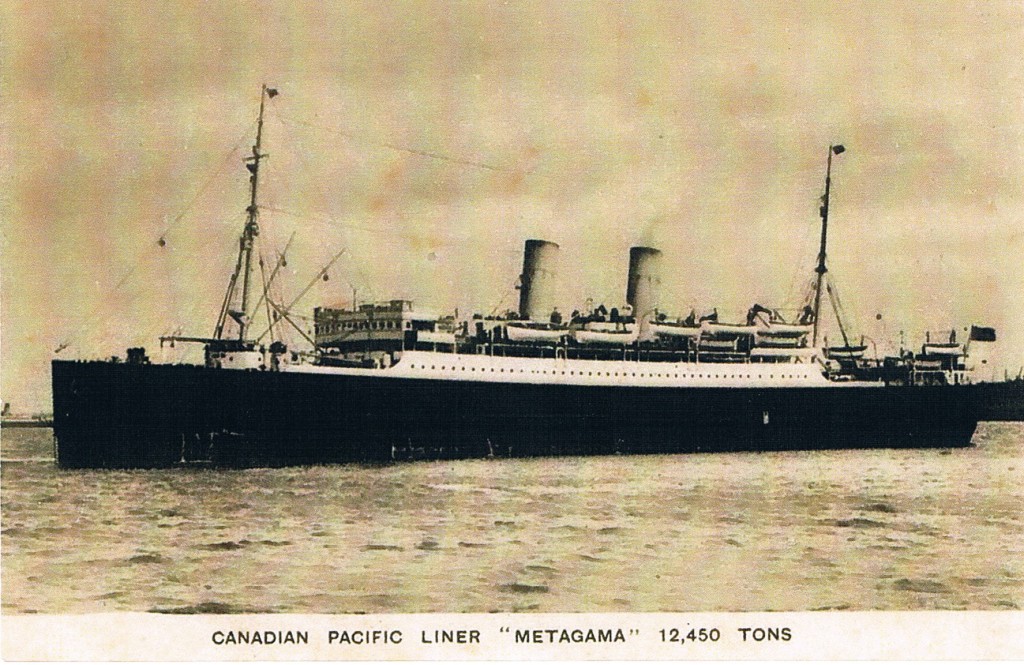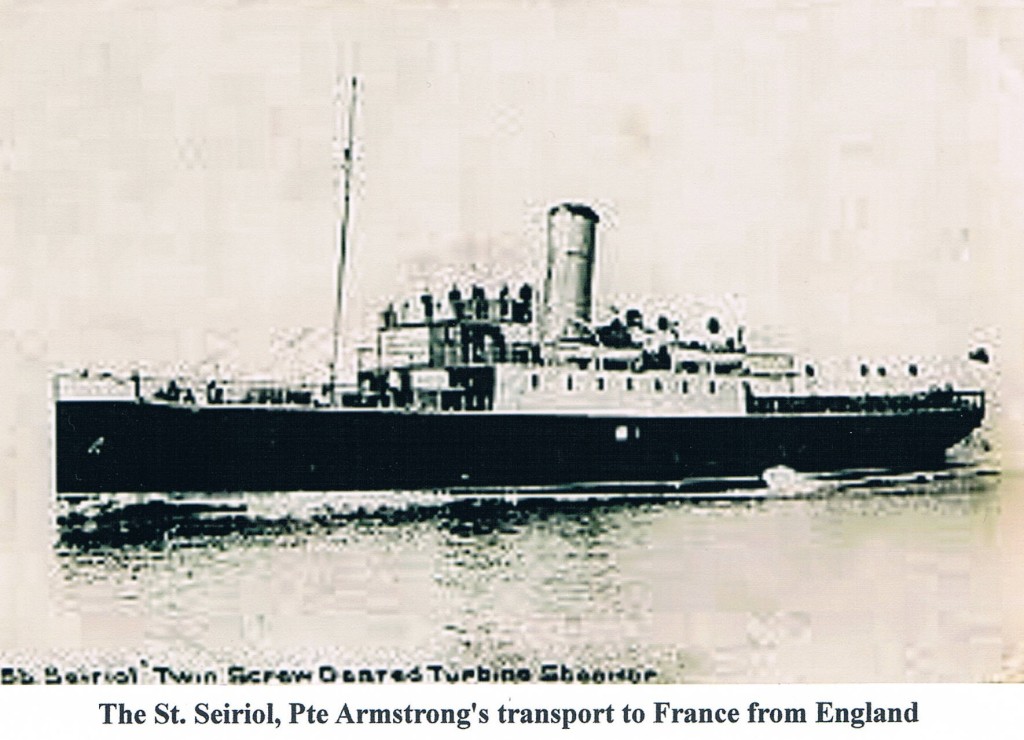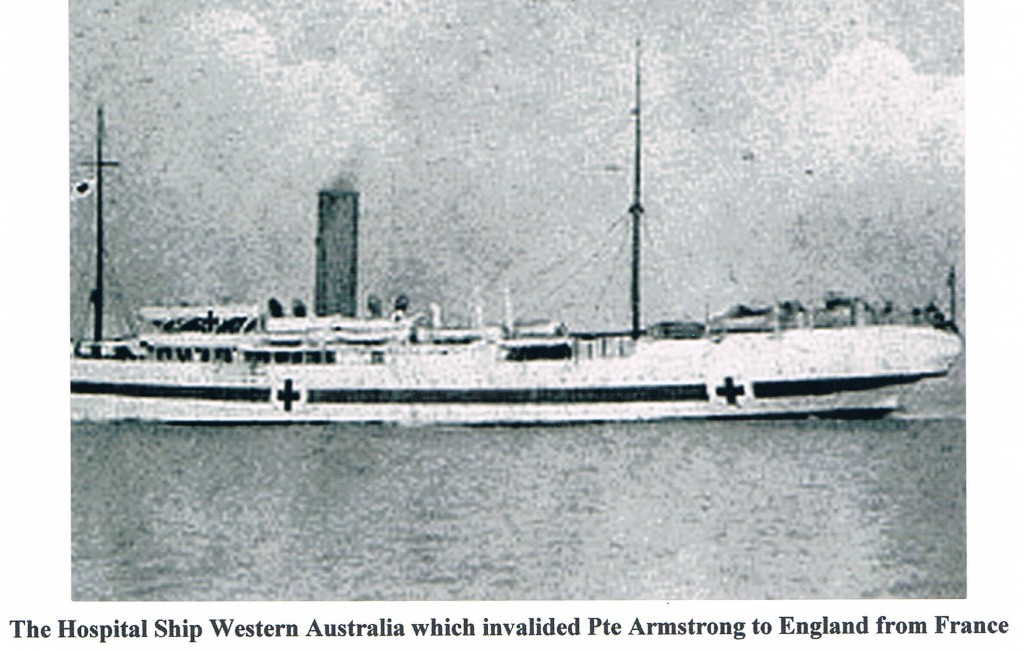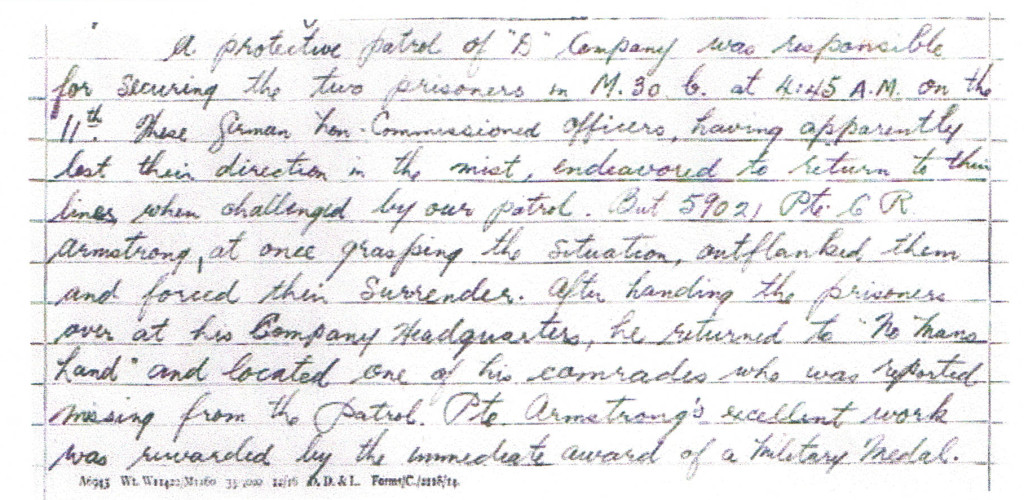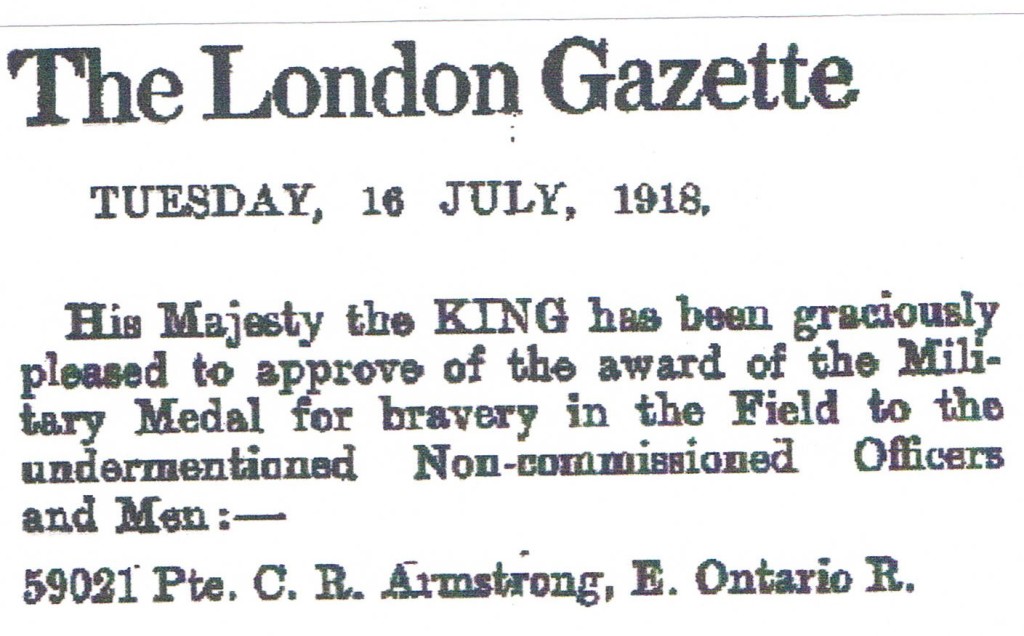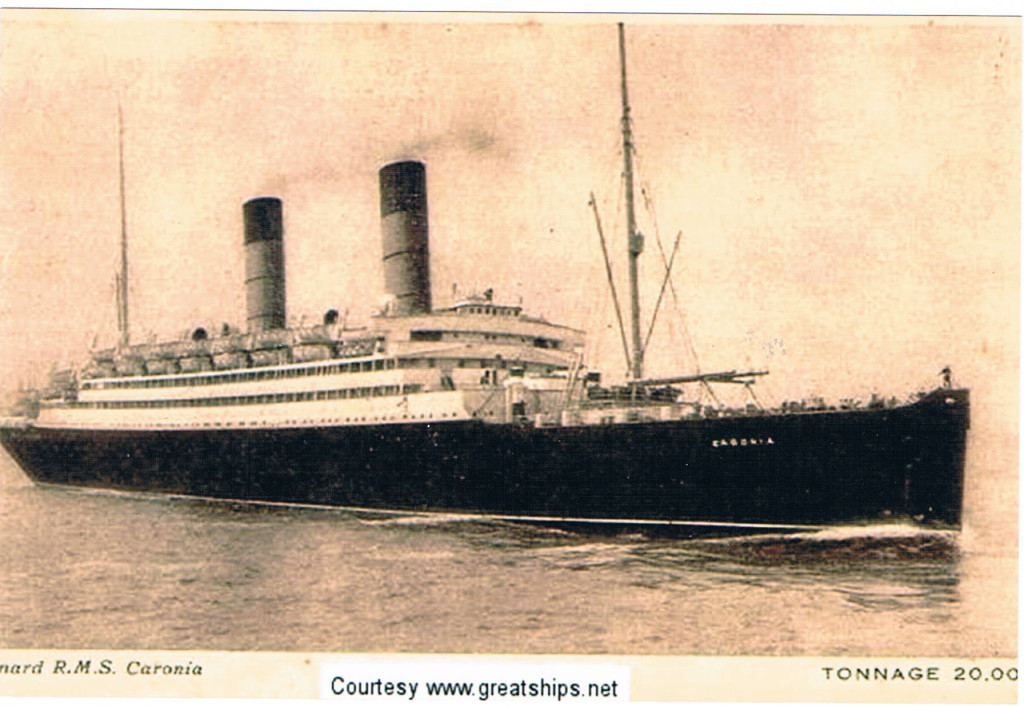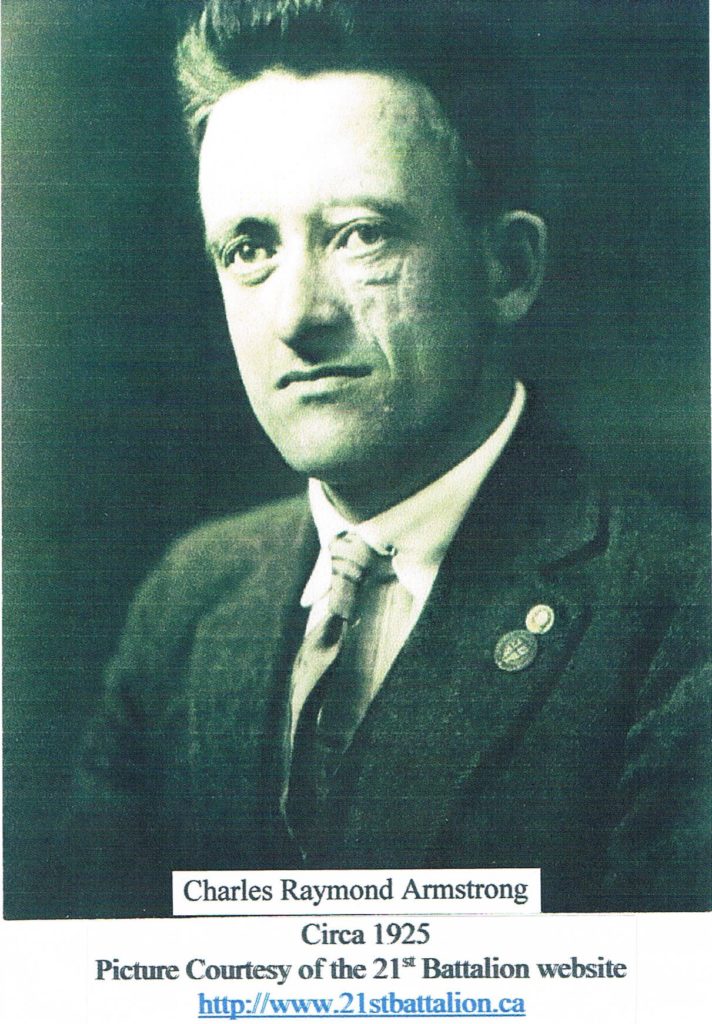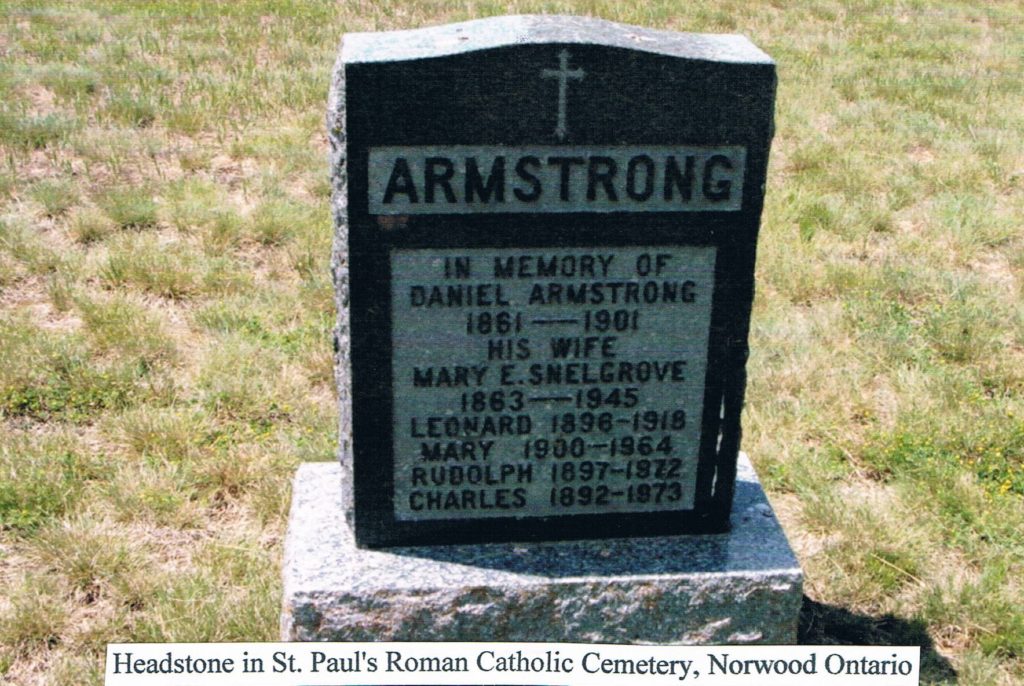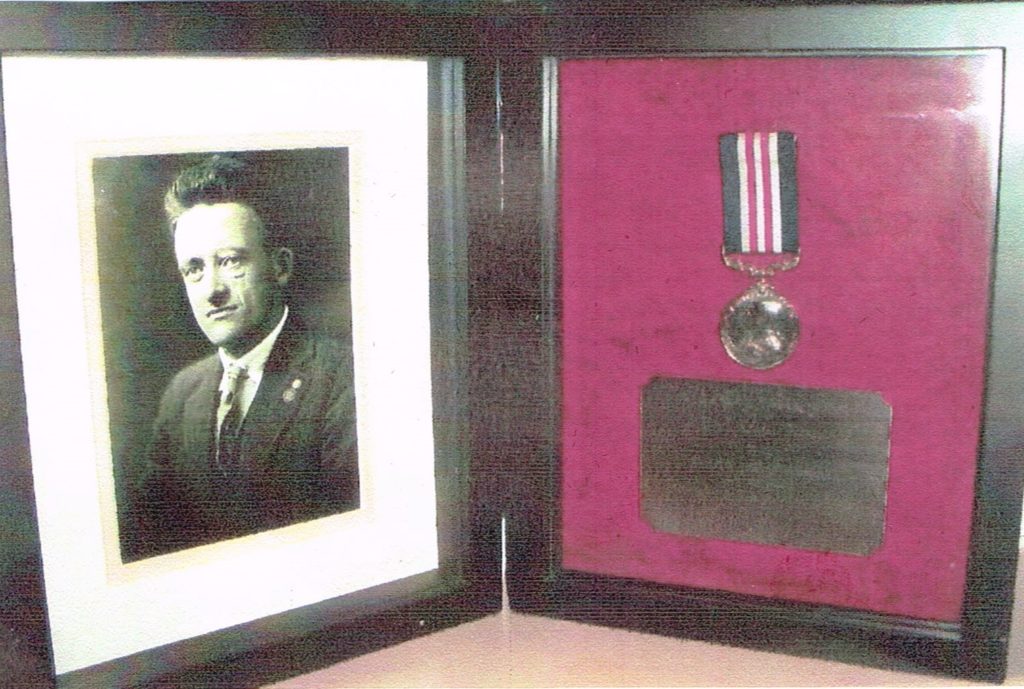MILITARY HISTORY
Private Charles Raymond Armstrong MM — 59021 — ACTIVE SERVICE (World War I)
Charles Raymond Armstrong was 21 years, 3 months old when, as a single man, he was attested in Kingston, Ontario on November 11, 1914 with the 21st Battalion, Canadian Over-Seas Expeditionary Force (CEF). Charles Raymond enlisted for the duration of the War as a Private (Pte) with the 21st Battalion (21 Bn) and was assigned Service Number 59021. Charles Raymond stated that he was born in Lakefield, Ontario on August 12, 1893; that he was 5′ 3″ tall, had brown hair, brown eyes and chest 35″. He indicated that he had no previous military experience. His previous employment was listed as a clerk. Charles Raymond lived in Lakefield Ontario and his next-of-kin was listed as Mrs. M. E. Armstrong, also of Lakefield Ontario. Charles Raymond’s father, Daniel, had died and his mother, Mrs. Mary Ellen Armstrong, lived in Lakefield. Pte Armstrong’s entry medical was done in Kingston Ontario, November 11, 1914. He had a scar on his right hand and left cheek and also slight varicose veins on the back of his right thigh; he was considered fit for duty. Pte. Armstrong was assigned to “G” Company (G Coy), 21 Bn and later was assigned to D Coy.
Although not stated in his Military Records; Pte Armstrong’s basic and some advanced training would have been conducted in Kingston Ontario prior to embarking for England.
On May 6, 1915 Pte Armstrong embarked the RMS Metagama at Montréal, Québec for the United Kingdom (UK). He disembarked at Devonport, England May 15, 1915 and proceeded to West Sandling Camp, near Hythe Kent.
The RMS Metagama, Pte Armstrong’s transport to England from Montréal, Québec
Although not shown in his Military Records; Pte Armstrong would have been on training conducted in at West Sandling Camp, England prior to embarking for France. On September 14, 1915 Pte Armstrong embarked the St. Seiriol at Folkstone, England for France. He disembarked September 15, 1915 at Boulogne, France and proceeded to St. Omer.
Although not stated in his Military Records; Pte Armstrong would have had additional training in the Field and he would have been deployed at the Front from September 15, 1915 to April 1916. On April 10, 1916 Pte Armstrong, while at the Front at St. Eloi, initially was reported missing and believed wounded and was found admitted to the No 4 Canadian Field Ambulance (CFA); the first stop for wounded men, with a gunshot wound (GSW) in his right wrist causing a compound fracture. Because the Medical Officer thought this wound appeared to be accidental in nature, a statement was requested as to how this happened. Following is the statement given by Pte Armstrong*:
On April 10th I was one of a bombing party who manned a crater in front of our lines until dusk. At dusk, about 7:00 pm, we went back to headquarters, but as no relief was ready, were ordered up again. While working our way up under an exceptional heavy shell fire to the crater, and taking protection in shell holes, two high explosive shells fell quite close to me, the first one knocking me flat, getting up I heard another coming very close and pushed myself through a hedge with rifle in Right hand, then turned around and jerked the rifle through. At the same moment the shell exploded about ten feet from me blowing me over in a hole. Apparently the rifle went off while pulling it through the hedge, but as the shell must have exploded at the same time, and stunned me, I did not realize I was shot, and when I did know I was hurt, thought it was the shell or machine guns which were shooting very close.
It was only when the dressing put on by stretcher bearers was being changed by the Medical Officer that he had called my attention to the powder marks around wound, saying it was likely caused by close rifle fire.
It was not my own Medical Officer who remarked this or dressed my wounds, but one at Voormezeele whom I do not know. Stretcher bearers took my rifle. At the time of the accident we were advancing in scattered formation, about 20 or 30 paces apart, each choosing his own path, and it being dark, know of no one who witnessed the accident.
This was signed by Pte Armstrong
On April 11, 1916 Pte Armstrong was transferred to the 2nd Army Special Hospital. Twelve days later, April 23, 1916, he was transferred to No 22 General Hospital at Camiers, France. Four days after that, April 27, 1916, Pte Armstrong was invalided to England aboard the Hospital Ship Western Australia and transferred to the Canadian Casualty Assembly Centre (CCAC) while in hospital at Folkstone, England.
April 28, 1916 he was taken-on-strength to the CCAC and admitted to the Thorpe War Hospital at Norwich, England. Then, on May 31, 1916 Pte Armstrong was transferred to the Canadian Convalescent Hospital at Woodcote Park, Epsom, England. July 5, 1916 he was discharged from
hospital and transferred from the CCAC to the 391 Reserve Battalion at West Sandling Camp, England. On October 27, 1916, after training at West Sandling Camp, Pte Armstrong was posted to the 21st Battalion. November 3, 1916 Pte Armstrong arrived at Canadian Base Depot (CBD) at Le Havre, France and was taken-on-strength, in the Field, with the 21st Bn. Then on November 17, 1916 he was admitted to No 39 General Hospital at Le Havre, France and was diagnosed as “not yet determined” (NYD) but was later changed to read Erythemia, an infection.
On November 20, 1916 Pte Armstrong was discharged from No 39 General Hospital to Reinforcements at Le Havre. November 29, 1916 he proceeded to the 2nd Entrenching Battalion. On December 12, 1916 Pte Armstrong was admitted to a Field Ambulance Unit and then transferred to No 5 Canadian Field Ambulance (CFA) December 14, 1916 with an Inner Connective Tissue (ICT) infection of the left knee. The same day he was transferred to No 4 CFA, the Divisional Rest Station (The Rest Station was for soldiers recuperating from wounds and illness. They most often receive physio-therapy there and got back into shape in order to return to the Front.) where he remained until December 23, 1916 when he was discharged to the Field with the 21st Bn. February 21 Pte Armstrong left to join his Unit and on February 22, 1917 he rejoined the 21st Bn as a reinforcement. March 2, 1917 Pte Armstrong was attached to the 4th Canadian Trench Mortar Battery (4 CTMB). April 11, 1917, while at the Front at Vimy Ridge, he was wounded and admitted to the No 6 CFA then April 13, 1917, he was transferred to the Casualty Clearing Station (CCS). On April 16, 1917 Pte Armstrong was admitted to No 13 Stationary Hospital at No 1 Convalescent Depot at Boulogne, France with a wound to his left eyelid. April 28, 1917 he was declared unfit and was transferred to the 3 Large Rest Camp. The Rest Camp was for soldiers recuperating from wounds and illness. They most often receive physio-therapy there and got back into shape in order to return to the Front.
May 26, 1917 Pte Armstrong is taken-on-strength from the Rest Camp to the 2nd Canadian Infantry Base Depot (2 CIBD) Casualty Company. Then, May 27, 1917 he is struck-off-strength from 2 CIBD, as attached to 4 CTMB, to the Canadian Garrison Base Depot (CGBD). On June 6, 1917 Pte Armstrong left CGBD to join 4 CTMB, in the Field. June 22, 1917 he was admitted to No 4 Stationary Hospital with Conjunctivitis. June 27, 1917 Pte Armstrong was discharged from No 4 Stationary Hospital to his Unit with 4 CTMB. On July 2, 1917 Pte Armstrong was taken-on-strength to CGBD Training Battalion (TB) from the Assistant Director of Medical Services (ADMS). Still under command of the CGBD, he left to join 4 CTMB in the Field on August 1, 1917 and rejoined them August 4, 1917. On August 14, 1917 Pte Armstrong joined the 2nd Division Training Battalion and on August 20, 1917 he rejoined 4 CTMB.
October 13, 1917 Pte Armstrong ceased to be attached to 4 CTMB and rejoined the 21st Battalion. November 9, 1917 he was admitted to 12 CFA with an ICT infection in his legs and transferred the same day to No 3 Casualty Clearing Station (3 CCS), (where the wounded men would receive further treatment and possible surgery), which contains the Canadian Corps Rest Station (CCRS). November 11, 1917 Pte Armstrong was transferred to No 56 General Hospital at Etaples, France. On November 24, 1917 he was transferred to No 6 Convalescent Depot at Etaples, France. November 29, 1917 Pte Armstrong was admitted to No 3 Rest Camp. Then on December 1, 1917 Pte Armstrong was transferred to No 14 Convalescent Depot at Trouville, France and December 2, 1917 he was admitted. As of January 18, 1918 Pte Armstrong was still a patient at No 14 Convalescent Depot.
On January 19, 1918 Pte Armstrong was discharged from No 14 Convalescent Depot to the Base Depot. January 21, 1918 he was taken-on-strength from No 14 Convalescent Depot to 2 CIBD, Casualty Company. February 4, 1918 Pte Armstrong left 2 CIBD for Canadian Corps Reinforcement Camp (CCRC) at Le Havre and joined them the same day. On February 14, 1918 Pte Armstrong left the CCRC to join his Unit; he joined the 21st Bn in the Field, February 16, 1918. February 22, 1918 Pte Armstrong was granted 14 days leave and rejoined his Unit March 11, 1918.
April 11, 1918 the following the following entry was made in the 21st Battalion’s War Diary*:
July 16, 1918 Pte Armstrong was awarded the Military Medal for bravery as per the London Gazette #30797* as follows:
September 17, 1918 Pte Armstrong was attached to the 2nd Canadian Division Salvage Company. November 14, 1918 he ceased to be attached and rejoined the 21st Battalion. On November 28, 1918 Pte Armstrong was admitted to No 6 CFA and then transferred to No 44 CCS with Dysentery. November 30, 1918 Pte Armstrong applied for the War Service Gratuity. On December 3, 1918 he was transferred to the CCS at Mons, France and the diagnosis was changed to read Urethritis (an infection of the Urethra). December 4, 1918 Pte Armstrong was transferred to 1/3 Lowland Field Ambulance and on December 5, 1918 he was admitted to No 33 CCS. Then on December 7, 1918 he was transferred to No 36 CFA.
On December 8, 1918 Pte Armstrong was transferred from No 36 CFA to No 51 General Hospital. December 18, 1918 he was admitted to No 6 Canadian Convalescent Depot (CCD) and on January 6, 1919 he arrived at the Canadian Infantry Base Depot (CTBD). January 19, 1919 he was struck-off-strength from the 21st Battalion Overseas and taken-on-strength with the Eastern Ontario Regimental Depot (EORD) at Seaford, England for discharge due to being medically unfit. After four months waiting at Seaford, on May 22, 1919, Pte Armstrong left the EORD and was moved to the Canadian Concentration Camp (CCC) at Witley, England pending return to Canada. On May 23, 1919 he was posted from the EORD to “M” Wing CCC for processing. June 8, 1919 his Medical History was done; at this time Pte Armstrong indicated that his birth date was August 12, 1894*. He was 5′ 5″ tall, dark hair, gray eyes, weighed 125 pounds and his former occupation was as a printer. The form states that he had impaired extension in his right wrist and slight weakness in his right hand which would require six months of medical treatment. He also had defective vision in his left eye caused by a High Explosive (HE) shell at Vimy Ridge which knocked him down and pushed the edge of his helmet into his eye; a permanent disability; not improved by glasses. June 25, 1919 Pte Armstrong embarked the RMS Caronia at Liverpool, England for Canada and was posted to Military District #3 (MD #3) at Kingston, Ontario. *1893 is on Attestation Paper and in Ancestry data.
The RMS Caronia, Private Armstrong’s transport to Halifax, Nova Scotia from England
July 2, 1919 Pte Armstrong disembarked at Halifax, Nova Scotia and proceeded to Kingston, Ontario. He was discharged at Kingston Ontario July 10, 1919.
Pte Armstrong was awarded the following medals:
Military Medal;
1914- 1915 Star;
British War Medal; and
Victory Medal.
He was also awarded War Service Badge – CEF Class “A” and War Service Badge – CEF Class “B” due to a medical discharge.
Charles Raymond Armstrong served for 6 months in Canada, 4 months in the United Kingdom and 3 years, 5 months in France. During his time in the Service he allotted $20.00 per month of his pay to his mother through the Royal Bank of Canada, Lakefield Branch, Lakefield Ontario.
Charles Raymond Armstrong died July 1, 1973 in Lakefield Ontario. He is interred in St. Paul’s Roman Catholic Cemetery, Norwood Ontario.
* Courtesy of the 21st Battalion website http://www.2lstbattalion.ca
An excerpt from an article in McLean’s magazine by Barbara Amid, September 1996:
The military is the single calling in the world with job specifications that include a commitment to die for your nation. What could be more honorable?
PERSONAL HISTORY
CHARLES RAYMOND ARMSTRONG
Charles Raymond Armstrong was born to Daniel & Mary Ellen August 12, 1891. His date of birth was also listed as 1892 and 1893 in different places. According the 1901 Census Charles was born in the USA and immigrated to Canada in 1891. Neither Charles nor his family were located on the 1891 Census which may mean that the family may have lived in the USA after 1881 sometime and returned after April 1891. It is believed that Charles attended school in Lakefield prior to enlisting in the Canadian Army. After serving in WW 2 Charles became a member of the Canadian Legion. According to the 1911 Census Charles was living with his mother and siblings on Albert Street, Lakefield. Mary was a widow and Charles was not married.
Charles was a member of the Royal Canadian Legion, Branch 77, in Lakefield Ontario. He was also a member of the Lakefield Council for 2 or 3 years and after that was instrumental in getting a walkway put in through the “swamp”. Charles played the banjo and the violin; he enjoyed playing with the guys. He was employed on construction work from time to time.
Charles Raymond Armstrong died July 1, 1973 in Lakefield Ontario.
THE CHARLES RAYMOND ARMSTRONG FAMILY OF LAKEFIELD
Charles Raymond Armstrong’s paternal grandparents were Charles Armstrong born in 1821 and Mary Keogan born in 1831. Charles was a farmer living in Dummer Township and passed away on August 24, 1884 and Mary passed away on January 17, 1891; both are buried in St. Paul’s Roman Catholic Cemetery in Asphodel Township.
Charles Raymond’s parents, Daniel, born May 1859 in Ontario and Mary Ellen Snelgrove, born January 30, 1863 were married in Northumberland County at Hastings, Ontario on September 1, 1884 by Rev. Wm. John Smith. Witnesses at their wedding were John Kelly and Emma Armstrong, both of Dummer Township. Daniel & Mary Ellen had the following children: Harry; Charles Raymond, Leonard Ferdinand; Rudolph Jerome and Mary Evelyn. According to Mary Evelyn’s Birth Certificate there were also four other children who did not survive. According to the 1921 Census Harry was a clerk, Charles was a student, Rudolph was a labourer and Mary Evelyn was a student. Leonard was not there but a Leonard was found married to Hilda with a 5-year old child in Woodstock, Ontario and listed as a driver.
Charles Raymond’s brother, Leonard Ferdinand, of Lakefield, Ontario, was drafted under the Military Service Act, 1917 and taken in on July 21, 1918. He was enlisted as a Private with Regimental Number 3134502 with the 1st Depot Battalion, Western Ontario Regiment. Unfortunately he died of the Spanish Flu in 1918 completing much training.
MODEST SOLDIER’S STORY FINALLY TOLD
PRIVATE CHARLES RAYMOND ARMSTRONG
Research for a school project brought three generations of a family together to celebrate an uncle’s heroism – writes Katie Daubs.
Charles Raymond Armstrong was born in the United States of America on August 12, 1892, son of Daniel Armstrong and Mary Ellen Snelgrove. By 1901 the family was living on Albert Street in Lakefield. Private Charles Raymond Armstrong enlisted to serve his country and King on November 11, 1914 and returned home on July 10, 1919. Charles passed away on July 1, 1973 and is buried in the family plot in St. Paul’s Roman Catholic Cemetery in Asphodel Township.
Uncle Charlie never said much. He was a quiet man who played a mean fiddle and made the best dandelion wine around. When he came back to Lakefield, a small community near Peterborough, after the First World War, he never married, never had children and he never, ever talked about Vimy Ridge. When Charles Armstrong died in July 1, 1973, all of his untold War stories and medals were buried with him.
It was only after his great-great-nephews started doing research for a school project that his story began to piece itself together. As it turns out, the quiet carpenter who beautifully renovated his brother’s home also won the Military Medal for bravery at Vimy Ridge – and never told anybody. On November 11, 2006, three generations of his family – his niece Dorothy Armstrong-Carroll, her son Stephen Carroll and her grandsons Spencer and Ashton Carroll, all of Ottawa, laid a wreath at the National War Memorial to commemorate the 90th anniversary of the battle. They were among the diplomats, veterans and other family members who came to pay homage to the Canadian effort at Vimy Ridge.
In her speech, Governor General Michaelle Jean spoke to the families of the six soldiers killed by a roadside bomb in Afghanistan. She told them they were “not alone in this trial” and that the rest of Canada is with them. Looking out at the sea of veterans, Ms. Jean also had a message for the youth. “You, the youth of our country, have a duty to remember those who sacrificed their own youth, if not their lives, in the name of justice and freedom. The legacy they have handed down must stand the test of time,” she said.
The Carroll family has taken those words to heart. Since beginning their research over the Christmas break at Library and Archives Canada, they’re slowly filling in the missing pieces of their uncle’s story.
Charles Raymond Armstrong was 22 when he enlisted in the Army. A member of the 21st Battalion, Eastern Ontario Regiment, he went to the Front in France in September 1915. Spencer and Ashton Carroll, his great-great-nephews, found out their uncle was wounded twice in the War.
They wore gloves to go through a box of old, handwritten records, where Spencer, 15, found a letter an officer had written about his uncle’s first injury. “There was an explosion beside him and he jumped through the bushes, and shot himself in the right hand,” Spencer said. “It took him out of the War for a while, but he went back in for Vimy.” At Vimy Ridge, Charles was injured by shrapnel. His helmet fell down across his face, leaving him with a scar. Among the medical records, there was another, curious document – a small handwritten note that simply said, “Military Medal”. There was nothing else – no date, no explanation.
Spencer’s father, Stephen Carroll, says the family had no idea the medal even existed. He said the family recently found out the Lakefield Legion had asked Uncle Charlie for the medal before he died. Without any fanfare, he gave it to them. The family is planning their next research trip to the Lakefield Legion to see what they can find out. “It belongs to Charlie, it belongs to the Legion, it belongs to Canada,” Mr. Carroll said.
He said his family doesn’t have any plans to take it back. They’re happy just to piece together their uncle’s story. “Not many of my friends are interested in military history, but I find it really exciting because it’s a part of Canada’s history,” said Ashton, 13.
When they found out about the wreath-laying ceremony a couple of months ago, they decided they would surprise their grandmother, Dorothy, Uncle Charlie’s niece. They told her a few days ago and presented her with a framed collection of documents and photos.
Charlie “never talked about the War,” she said. “My father told me a little bit, but not much. Anything I did find out I found out from my grandsons, when they started doing this project.” Said Spencer, “It was exciting and important to do this research. It was the birth of Canada, when they took Vimy. I’m glad to do it for the survivors of Vimy and we’re three generations, doing it together.”
PRIVATE CHARLES RAYMOND ARMSTRONG – 1892-1973
(Compliments to Katie Daubs and the Charles Raymond Armstrong Family)

